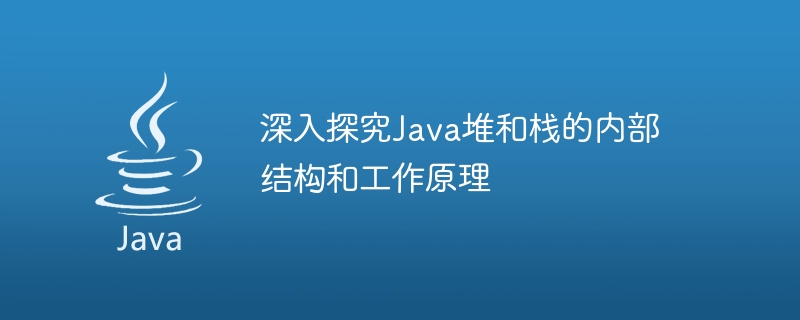

In-depth exploration of the internal structure and working principles of Java heap and stack
As an object-oriented programming language, Java’s memory management mechanism is one of its core features . In Java, the heap and stack are two important memory areas, and different data types are stored in different memory areas. To gain a deeper understanding of the internal structure and working principles of Java heap and stack, we will discuss them in detail in this article.
First, let us understand the Java heap. The Java heap is an area of memory used to store object instances. It is one of the runtime data areas managed by the Java virtual machine. The Java heap is not thread-private, but thread-shared. Its size is determined when the Java virtual machine starts and can be adjusted through virtual machine parameters.
The Java heap can be divided into three parts: the new generation, the old generation and the permanent generation (in the latest JDK version, the permanent generation has been replaced by metaspace). The new generation is used to store new objects. Most objects will be recycled shortly after they are created. The new generation is divided into Eden space and Survivor space (usually two).
When an object is created, it will be allocated to the Eden space. When the Eden space is full, a garbage collection of the new generation will be triggered. When recycling, the Java virtual machine finds all surviving objects and copies them to one of the Survivor spaces, while clearing the Eden space. After each recycling, the surviving objects in the Eden space will gradually move to the Survivor space. If they still survive after multiple recycling, they will eventually be moved to the old generation.
The old generation mainly stores some objects with long life cycles, such as objects that survive for a long time. Garbage collection in the old generation is called Full GC and usually takes longer to complete. In order to avoid the frequent occurrence of Full GC, some special objects will be allocated directly to the old generation, such as large arrays or large strings.
Another memory area is the Java stack. The Java stack is thread-private, and each thread is allocated a Java stack when it is created. Memory allocation and recycling of the Java stack are performed automatically. Each method call creates a stack frame in the Java stack. The stack frame contains the method's local variables, operand stack and other information. When the method execution is completed, the stack frame will be popped and the corresponding memory space will be released.
The size of the Java stack is fixed when the virtual machine is started and cannot be adjusted. If there is insufficient Java stack space, a stack overflow exception will be thrown. Recursive method calls are one of the most common causes of stack overflow.
Java heap and stack play an important role in memory management. The heap is used to store object instances, while the stack is used to store state information for method calls. Understanding their internal structure and working principles can help us better perform memory optimization and performance tuning.
In short, the Java heap and stack are the key memory areas of the Java virtual machine. The heap is used to store object instances and is divided into the new generation, old generation and permanent generation (metaspace); the stack is used to store status information of method calls. Correctly understanding and rationally utilizing the Java heap and stack is crucial to the performance optimization and memory management of Java programs. I hope that through the introduction of this article, readers will have a deeper understanding of the internal structure and working principles of the Java heap and stack.
The above is the detailed content of Deep understanding of the internals and workings of the Java heap and stack. For more information, please follow other related articles on the PHP Chinese website!




